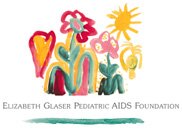Facts About HIV / AIDS
 On May,8,2001,Paul testified before a Senate committee on the need for continued federal incentives for drug companies to test and develop pharmaceuticals to combat childhood disease. Each day, more than 1,600 babies are newly infected with HIV around the world.You canread his testimonies at EGPAF.
On May,8,2001,Paul testified before a Senate committee on the need for continued federal incentives for drug companies to test and develop pharmaceuticals to combat childhood disease. Each day, more than 1,600 babies are newly infected with HIV around the world.You canread his testimonies at EGPAF.
FACTS ABOUT AIDS
- Worldwide more than 36 million people are HIV-infected; 95 percent of these people live in developing nations
Around the world, more than five million people are newly infected each year
Half of new infections are in young people (age 15-24) and 40 percent are women
Newborns comprise 600,000 of the newly infected people - More than 500,000 children die annually from AIDS
What isHIV?
HIV stands for Human Immunodeficiency Virus. HIV attacks the immune system (the part of your body that protects against infections and illnesses). This is the virus that causes AIDS. A person can be HIV positive and not have AIDS. Once infected, the avaerage time it takes to develop AIDS is about 10 years, depending on the health of the imuune system and the individual. new advances in medicine are today, extending the development of AIDS.
What is AIDS?
AIDS stands for Aquired Immune Deficiency Syndrome. This is the disease caused by the virus HIV. It is the point at which the body can no longer fight off infections and diseases.
What are the symptoms of AIDS?
ONLY a medical doctor can diagnose AIDS. Common symptoms include: fatigue; chills, nightsweats: swollen glands: pink to purple spots on skin: whte spots and sores in mouth: persistent diarrhea: weight loss of 10pounds or more: a dry heavy cough: shortnes or breath: repeated serious vaginal yeast infections.
What is the test for HIV/ AIDS?
A blood test known as the HIV ANITIBODY is the only way to know if a person is infected with the AIDS virus. It takes 6 weeks to 6 months for a test to be postive once a person is infected. A positive test means that the person is infected and can pass the HIV virus to someone else. Please, if you think you have been exposed, seek medical care. your blood test can be done with an anonymous name (ID).HIV is NOT spread by touching, kissing, sneezing, coughing, sharing silverware, cups or plates with an infected person. You Cant get the virus from swimming pools, bathtubs, showers, toilet seats, drinking fountains or insect bites. it is completely safe to donate blood and today, its very rare that someone gets HIV from transfused blood. The blood, vaginal fluid, semen, and breast milk of people infected with HIV has enough of the virus in it to infect other people. You can get HIV from anyone who\'s infected, even if they don\'t look sick, even if they haven\'t tested positive (yet). Most people get the HIV virus by:*Having sex with an infected person.
*Sharing a needle (shooting drugs) with someone who\'s infected
*Being born when the mother is infected, or drinking the breast milk of an infected woman
A wonderful book of hope and courage written by Elizabeth Glaser, of In The Absence Of Angels is available at
Tips for Talking with your partner about HIV/AIDS.
* Please talk about AIDS/ HIV protection before having sex.* Be open and honest.*Decide ahead of time how you will respond if your partner does not want to talk about it or respect your wishes. Remember, with AIDS, there are NO second chances. There is NO cure for AIDS (yet).
How HIV begins in your body.
When you have been exposed to HIV virus, your immune system responds, by making antibodies. When you start making antibodies, you will test positive for HIV.The virus attaches itself to "B cells" (cells that help fight off infection and produce anti-bodies). From here, the B cells mingle with "T cells" (cells that keep the immune system strong and healthy). This in turn, keeps duplicating itself producing more of the virus and decreasing your immune system.One way to measure the damage to your immune system is to see how many CD4+ cells you have. "T-helper" cells, are an important part of the immune system. Healthy people have between 500 and 1,500 CD4+cells in milliliter of blood.
Where did HIV/AIDS come from?
Scientists do not know and have several different theories about the origin of HIV, but none have been proven. The earliest known case of HIV was from a blood sample collected in 1959 from a man in Kinshasha, Democratic Republic of Congo. (How he became infected is not known.) Testing of his blood sample suggests that HIV-1 may have startedfrom a single virus in the late 1940s or early 1950s. Here in the US, the virus is thought to exhisted from the mid to late \'70\'s.
For more information on HIV/ AIDS, try these:
JAMACenters for Disease Control & Prevention (CDC) Healing Well
Please support the Elizabeth Glaser Pediatric Aids Foundation. The Foundation is dedicated to funding research on Pediatric HIV/AIDS and other childhood illnesses. Here are some of the many ways you can help support the EGPAF.
- Make a monetary donation.Donate your air miles.You can help support the EGPAF by doing your shopping here. Up to 15% of your purchase price will be donated to EGPAF.Design and conduct your own fundraiser.You can donate through United Way's payroll deduction.
- For more ways to help Click here!

